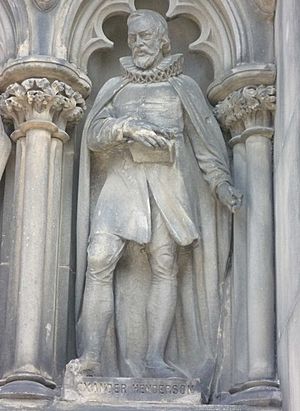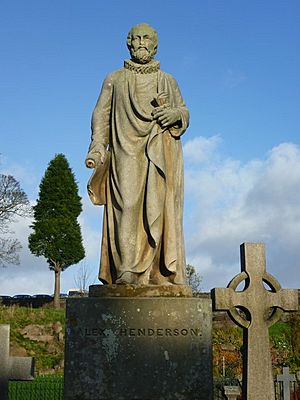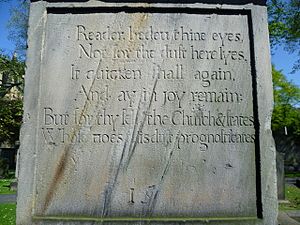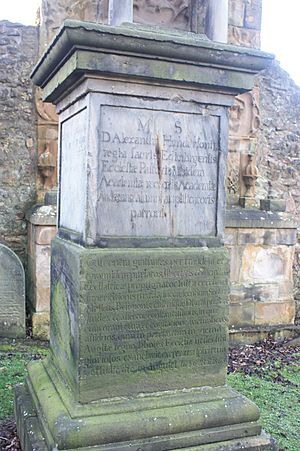Alexander Henderson (theologian) facts for kids
Quick facts for kids
Alexander Henderson
|
|
|---|---|
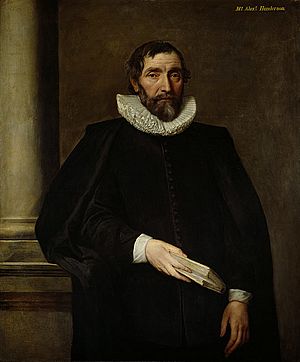 |
|
| Born | c. 1583 Guthrie, in the Fife parish of Creich
|
| Died | 19 August 1646 Edinburgh, Scotland
|
| Occupation | Pastor, author, reformer |
|
Notable work
|
The Government and Order of the Church of Scotland (1641) |
| Spouse(s) | none |
| Theological work | |
| Tradition or movement | Presbyterianism |
Alexander Henderson (born around 1583 – died 19 August 1646) was an important Scottish church leader and thinker. He is often called the second founder of the Reformed Church in Scotland. He was one of the most famous ministers of the Church of Scotland during a very important time in its history, in the mid-1600s.
Alexander Henderson was born in 1583. He studied at the University of St. Andrews. At first, he supported a church system led by bishops, called episcopacy. He was even forced into his first church job in Leuchars, Fifeshire, in 1615. But later, his ideas changed. He became a strong supporter of Presbyterianism, a system where the church is led by elected elders.
He stood against new church rules in 1618. He also resisted using a new prayer book in 1637. Henderson helped write two very important agreements: the National Covenant of 1638 and the Solemn League and Covenant of 1643. These agreements were signed by many Scots who wanted to protect their church.
He led a big meeting of the church, called the General Assembly, in Glasgow in 1638. He was chosen to lead this meeting two more times. He also became the head of Edinburgh University. King Charles I even made him his chaplain in 1641 to try and make peace with the Presbyterians.
Henderson went on important missions. He represented the Scottish Church at a big meeting of church leaders in Westminster, England. He also met with King Charles I several times. He tried to convince the king to accept Presbyterianism, but he was not successful. Alexander Henderson died in Edinburgh on 19 August 1646.
Template:TOC limit=3
Contents
Early Life and Education
Alexander Henderson was born in 1583 in a place called Guthrie, in the area of Creich in Fife. We don't know much about his parents. Some stories say his family were Hendersons of Fordel. This might be true because he is buried in their family graveyard. His birthplace was between the villages of Luthrie and Branton. He cared about education, leaving money in his will to help a school in Luthrie.
When he was 16, in 1599, he started studying at St Salvator's College at University of St. Andrews. He earned his master's degree in 1603. From 1603 to 1611, he taught philosophy there. During this time, he also finished his studies in religion.
A Change of Heart
When he first started his career, Henderson strongly supported the idea of bishops leading the church. This was called episcopacy. He was a big supporter of Archbishop Gledstanes, who helped him get his first job as a minister in the parish of Leuchars. His new job was not popular with the local people. On the day he was supposed to start, probably in January 1614, the church doors were nailed shut! He and his friends had to climb in through a window.
At first, Mr. Henderson didn't seem very interested in the spiritual needs of his church members. But then, his beliefs and character completely changed. This change happened after he heard a sermon by a famous preacher named Robert Bruce of Kinnaird. The story goes that Henderson secretly went to a church in a nearby town to hear Bruce preach. He tried to hide in a dark corner.
Bruce's sermon was about a Bible verse that said, "He that entereth not by the door..." This message seemed to fit Henderson's own situation perfectly, since he had entered his church by the window! The sermon deeply affected him. From that day on, he changed completely. He became a caring and dedicated minister. He also became a strong supporter of Presbyterianism, where the church is run by elected elders, not bishops. He now believed that the bishops' system was hurting religion.
His first public stand for Presbyterianism was at the Perth Assembly in 1618. He strongly spoke out against the "Five Articles," which were new rules the king wanted. He did this even though the government threatened anyone who opposed them. The archbishop of St Andrews warned that ministers would be banished or lose their jobs. But Henderson stood firm.
In 1619, he had to appear before a special court. He was accused of publishing a paper against the Perth Assembly. But Henderson spoke so well that the bishops couldn't win against him. They had to let him and his friends go, though they still gave them warnings. For the next 18 years, we don't know much about his life.
Fighting for the Church: The National Covenant
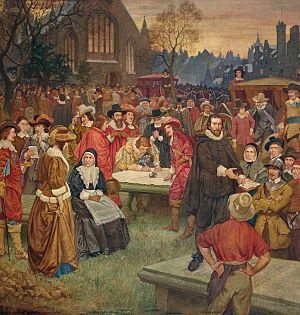
In 1637, Alexander Henderson became a key figure again. He strongly opposed a new prayer book called "Laud's Liturgy." King Charles I wanted to force this book on the Scottish Church. Ministers were told to buy two copies for their churches or face punishment.
Henderson immediately went to Edinburgh. On August 23, he asked the Privy Council to stop the order. He pointed out that the prayer book had not been approved by the Church's General Assembly or by Parliament. The council agreed to pause the order. However, King Charles insisted that the prayer book must be used. From this point on, Mr. Henderson played a major role in the protests.
Many nobles, gentry, ministers, and town representatives gathered in Edinburgh. After more requests to the king failed, the leaders decided to ask the people for support. This led to the renewal of the National Covenant. This important document was written by Mr. Henderson and Archibald Johnston.
On February 28, 1638, thousands of people signed and swore to the Covenant in Greyfriars' Church in Edinburgh. Henderson spoke to the huge crowd with great passion, and the people were incredibly enthusiastic. He then traveled to Aberdeen with other leaders to convince people there to sign the Covenant. About 500 people in Aberdeen signed it, including many important citizens.
Mainly because of Henderson's influence, the National Covenant was signed. He was also chosen to lead the important General Assembly meeting in Glasgow on November 21, 1638.
The National Covenant had three main parts:
- A statement of faith from 1581.
- A list of laws against Catholic practices.
- A promise to uphold the true reformed religion.
Henderson was very skilled at writing these important documents. In July 1638, he went north to discuss the Covenant with famous scholars in Aberdeen. But he was not well received there.
Henderson's next big moment was at the famous Assembly in Glasgow in November 1638. He was chosen as the leader, or "moderator," because everyone agreed he was the most capable person. The king's representative tried to stop the meeting when the Assembly wanted to put the bishops on trial. He even said it was treason to continue. But the Assembly believed they had the right to meet independently. They continued until December 20. They removed all the Scottish bishops, kicked some out of the church, and got rid of all laws that supported bishops. They rebuilt the Scottish Church based on Presbyterian rules. During this Assembly, Henderson was asked to move to Edinburgh, which he did, though he was sad to leave his old church.
Dealing with the King
In 1639, Henderson was one of the church leaders chosen to discuss peace with the king. He handled these difficult talks with great care and honesty. At the next Assembly meeting in August, the king's representative wanted Henderson to be chosen as moderator again. But Henderson himself strongly opposed this, and the Assembly agreed. They didn't want a permanent leader, as it went against their church rules. On August 31, he gave an excellent speech at the opening of Parliament. He spoke about the purpose and duties of leaders. He was again Moderator in 1639.
The king refused to agree to some of the peace terms. He then called the Covenanters rebels and prepared to invade Scotland again. But the Scottish army entered England in August 1640. This forced the king to agree to new peace talks. These talks started in Rippon and then moved to London. Mr. Henderson was one of the church's representatives. He stayed in London for nine months. During this time, he preached and wrote many papers to support the Scottish cause.
Before leaving London, he had a private meeting with the king. He wanted to get money for Scottish universities from the funds that used to go to the bishops. The king received him kindly.
University Work
In January 1640, Henderson became the head, or "Rector," of the University of Edinburgh. He held this job for the rest of his life. The city council wanted to improve education at the university. They chose Henderson to oversee the principal, professors, student education, and money. He worked hard to help the university. He especially focused on training future ministers. He also started a new professorship for studying Eastern languages, which had been neglected before.
Leading the Church Again
When Henderson returned to Edinburgh in July 1641, the General Assembly was meeting. To make it easier for Parliament, the Assembly moved to Edinburgh. Henderson was chosen as moderator again. In this Assembly, he suggested creating a new statement of faith, a catechism (a book of questions and answers about beliefs), a guide for public worship, and a plan for church government that England and Scotland could agree on. This idea was approved, and Henderson was given the big job of preparing these documents.
During King Charles's second visit to Scotland in 1641, Henderson served as his chaplain. He successfully arranged for money from the bishopric of Edinburgh to go to the university. The next year, Henderson tried to keep Scotland neutral in the war between the king and Parliament. He corresponded with England about church matters. Soon after, he was sent to Oxford to try and make peace between the king and Parliament, but his mission failed.
The Assembly also asked him to reply to a letter from London ministers who wanted advice on church government. Henderson urged that England and Scotland should have the same church government. The Assembly also approved his idea to create a Confession of Faith, Catechism, Directory of Worship, and Form of Government. He was asked to prepare the first drafts.
On August 14, the king arrived in Edinburgh for Parliament. To try and win over the Presbyterians, he appointed Mr. Henderson as his chaplain. While the king was in Edinburgh, Henderson led family prayers at the palace every morning and evening. He also often preached to the king in the chapel. During this Parliament, the money from the bishops' lands was divided. Thanks to Henderson's efforts, the money from the Edinburgh bishopric went to the university. He also received some money for his hard work for the public.
Some false rumors were spread about Henderson. In the next Assembly, he gave a long and emotional speech defending himself. His fellow ministers supported him and showed their trust, which cheered him up.
In 1641, he preached before King Charles at Holyrood and was made Dean of the Chapel Royal. He was chosen as Moderator for a third time on August 2, 1643. He was also chosen to be a member of the Westminster Assembly of Divines. He turned down the offer to be the head of St Mary's College, St Andrews. He died unmarried on August 19, 1646. Besides the Church, Henderson's greatest service was to the University of Edinburgh. He was seen as the best educator and had the clearest vision for the college since it began.
The English Civil War and Westminster Assembly
During 1642, the time of the English Civil War, Henderson worked on letters with England about church reform and unity. He was chosen as one of the people to go to England, but the civil war delayed him. He wanted to help King Charles and his English subjects make peace. He even joined others in inviting the queen to Scotland, but the king rejected this idea.
He then went to Oxford, where the king was, to offer Scotland's help in making peace. But the king would not make any compromises. He defended his actions and was angry that the Scots cared about reforming the church in England. When Henderson returned to Edinburgh, the General Assembly praised his "faithful and wise" actions during these difficult talks.
In 1643, he was chosen as moderator of the General Assembly for the third time. This meeting was special because English representatives came from Parliament to ask for Scotland's help and advice. Henderson was then appointed as one of the people who went to London to attend the Assembly of divines at Westminster. His job was to represent the Church of Scotland and to get the Solemn League and Covenant approved by that Assembly and by both houses of Parliament. This happened on September 25.
For the next three years, he stayed in London. He worked tirelessly to help the Westminster Assembly create public documents for a religious union between Scotland, England, and Ireland.
A very important meeting of the General Assembly happened in August 1643. Henderson was elected moderator for the third time. He presented a draft of the famous Solemn League and Covenant. This document was received with great excitement. Unlike the National Covenant of 1638, which was only for Scotland, this new document was for both kingdoms. Henderson, along with others, was sent to London to represent Scotland at the Westminster Assembly. The Solemn League and Covenant promised that both countries would get rid of bishops. It also said that the church government would be decided by looking at the best reformed churches. After some small changes, it passed both the Parliament of Scotland and the Parliament of England. This made it law for both kingdoms. Through this, Henderson had a big impact on the history of Great Britain.
As a Scottish representative to the Westminster Assembly, he was in England from August 1643 to August 1646. His main work was writing the Directory of Public Worship, which was a guide for how church services should be held.
Last Days
In early 1645, Henderson was sent to the Treaty of Uxbridge to help the representatives from both parliaments talk with the king. But nothing came of the meeting. In 1646, the king joined the Scottish Army. After going with them to Newcastle-upon-Tyne, the king sent for Henderson. They discussed the two church government systems in a series of written papers.
Meanwhile, Henderson's health was getting worse. He sailed back to Scotland. Eight days after he arrived, he died on August 19, 1646. He was buried in Greyfriars Kirkyard in Edinburgh. His death was a time of national sadness in Scotland.
A document was published in London claiming to be Henderson's death-bed statement. This paper was later proven false by the General Assembly in 1648. However, it was used by some to suggest that Henderson had changed his mind about his beliefs.
The failure of his last mission with the king was very hard on Henderson's already poor health. He had been ill for some time. He sailed from Newcastle to Leith and arrived home in Edinburgh. He was cheerful, but he said he wanted to leave this world more than a schoolboy wanted to play. He made his will on August 17 and died on August 19, 1646.
In the spring of 1646, when the king had given himself up to the Scottish army, he sent for Mr. Henderson. Henderson was seen as the best person to talk to the king. He arrived in Newcastle in mid-May and was welcomed by the king. But he soon realized that Charles still did not want to agree to establish Presbyterianism. They decided to discuss the king's doubts in a series of written papers. These discussions lasted from May 29 to July 15. There were eight papers in total: five from the king and three from Henderson. Henderson's health was very bad, so he had to travel by sea to Edinburgh. He died there on August 19, 1646, at 63 years old. His body was buried in Greyfriars churchyard, where his nephew built a monument to him.
Works
- The Government and Order of the Church of Scotland (1641)
- The answeres of some brethren of the ministerie : to the replyes of the ministers and professours of divinitie in Aberdeene, concerning the late covenent (1638)
- Reformation of church-government in Scotland : cleered from some mistakes and prejudices (1644)
- A sermon preached to the honourable House of Commons at their late solemne fast, Wednesday, 27 December 1643
- Generall demands concerning the late covenant propounded by the ministers and professors of divinity in Aberdene : to some reverend brethren who came thither to recommend the late covenant to them ... : together with the answers of those reverend brethren to the said demands .. (1662)
- Sermons, prayers and pulpit addresses (1867 printing)
- The Remonstrance of the Nobility, etc., within the Kingdom of Scotland, vindicating them and their Proceedings from the Crimes wherewith they are charged by the late Proclamation in England (1639)
- Speech delivered immediately before the taking of the Covenant by the House of Commons and Assembly of Divines (Edinburgh, 1643)
- Three single Sermons preached before the Houses of Parliament (London, 1644, 1644, 1645)
- The Bishops' Doc/m (Edinburgh, 1762)
- Declaration upon his Deathbed [concerning King Charles'] (1648)
- Sermons, Prayers, and Pulpit Addresses, edited from the original MSS. by E. Thomson Martin (Edinburgh, 1867).
Images for kids


